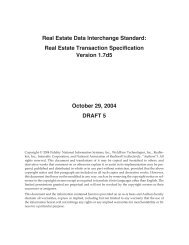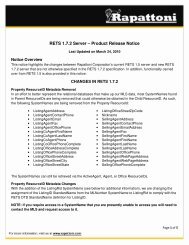Specification - RETS
Specification - RETS
Specification - RETS
You also want an ePaper? Increase the reach of your titles
YUMPU automatically turns print PDFs into web optimized ePapers that Google loves.
[ServerInformation = server-information-URL CRLF]<br />
[Update = update-URL CRLF]<br />
Table 4-2<br />
Parameter<br />
action-URL<br />
Capability URL Descriptions<br />
change-password-URL<br />
get-metadata-URL<br />
get-object-URL<br />
login-URL<br />
login-complete-URL<br />
logout-URL<br />
search-URL<br />
update-URL<br />
server-information-URL<br />
Purpose<br />
A URL on which the client MUST perform a GET immediately after<br />
login. This might include a bulletin or the notification of email. The<br />
client application SHOULD provide a means for the user to view<br />
the retrieved document. A server is not required to supply an<br />
Action URL.<br />
A URL for the ChangePassword transaction.<br />
A URL for the Get Metadata transaction.<br />
A URL for the Get Object transaction.<br />
A URL for the Login Transaction. The client software should use<br />
this URL the next time it performs a Login. If this URL is different<br />
from the one currently stored by the client the client, MUST update<br />
the stored one to the new one. This provides a mechanism to move<br />
the Login server.<br />
RESERVED<br />
A URL for the Logout transaction.<br />
A URL for the Search transaction.<br />
A URL for the Update transaction.<br />
A URL for the System Information transaction<br />
The URLs in the capability-url-list may be specified in any order. Since the list is returned<br />
in the body, servers MAY include whitespace between the parameter, equals sign and URL.<br />
Clients SHOULD be prepared to receive the capability-url-list either with or without<br />
whitespace in the response. The format of each URL follows the pattern defined in the URL<br />
atom. In addition, the table is extensible; servers may define additional transactions for<br />
clients to access. If a transaction is offered only to particular user agents, the keys for those<br />
additional transactions MUST begin with the user-agent token, followed by a dash “-”,<br />
followed by an implementation-defined function name. Note that this definition does not<br />
permit spaces in the additional-transaction definition per the ABNF rules.<br />
additional-transaction ::= (“X” | user-agent-token ) “-” function-name CRLF<br />
user-agent-token ::= <br />
function-name<br />
Example:<br />
Example:<br />
::= 1*ALPHA<br />
MLSWindows-special = /special_function<br />
X-Delete = http://www.example.com:6103/deletemyrecord<br />
A compliant client need not recognize any transaction that is not included in this<br />
specification. If some extended transactions are offered to any user-agent, the keys for<br />
those transactions MUST begin with an “X” followed by a dash, followed by an<br />
implementation-defined function name. Server implementers who implement potentiallyunrestricted<br />
extension transactions are urged to register their keys and service descriptions<br />
on the <strong>RETS</strong> web site to encourage wider adoption.<br />
URLs other than the Login URL may be relative URLs. The Login URL MUST be an<br />
absolute URL. If a URL is not absolute, the client application should canonicalize it<br />
according to the rules in RFC 2396, section 5. The “base URL” (as defined in RFC 2396,<br />
Version 1.7.2 4-7




